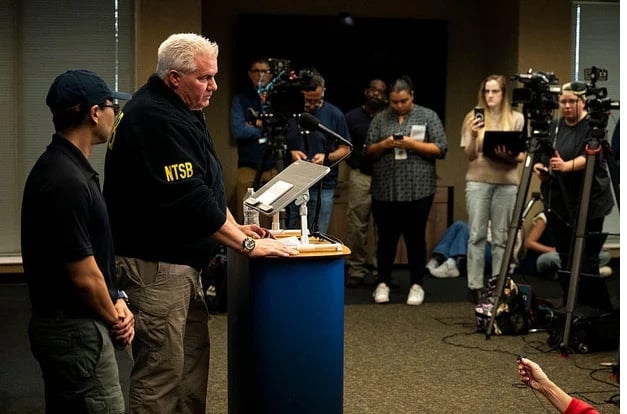UPS plane engine fell off during crash in Louisville, NTSB official says
A UPS cargo plane’s left wing caught fire and an engine fell off just before it crashed and exploded after takeoff from Louisville International Airport in Kentucky, a federal investigator said Wednesday, offering the first official details about a disaster that killed at least 12 people.
There was a fire in the plane’s left wing and the engine “detached” during takeoff on Tuesday, said Todd Inman, a member of the National Transportation Safety Board, which is leading the investigation.
“There are a lot of different parts of this airplane in a lot of different places,” Inman said during a news conference, describing a debris field that stretched for a half-mile.
The plane with three people on board crashed about 5:15 p.m. ET on Tuesday as it was departing for Honolulu from UPS Worldport at Louisville International. Video showed flames on the plane’s left wing and a trail of smoke.
“The plane lifted off and gained enough altitude to clear the fence at the end of Runway 17R. Shortly after clearing that fence, it made impact with structures and the terrain off of the airport property,” Inman said.
Inman said the plane’s black boxes — the cockpit voice recorder and the flight data recorder — were recovered by NTSB investigators on Wednesday afternoon.
He said the black box “suffered some heat around it, not intrusion,” but added that “the recorders are built for that.”
“We feel comfortable, once we get these to our lab in D.C., that we will be able to get a good readout of the applicable data,” Inman said. “And that will be yet another point of information that will really help us understand what happened during this point of flight.”
Inman said the crashed plane was a 1991 McDonnell Douglas 2 that was “altered” into a McDonnell Douglas MD-11 Freighter. He disclosed that the plane was currently being “handled” by aircraft manufacturing giant Boeing, which merged with McDonnell Douglas in 1997.
“So whenever you hear that Boeing is a party, it is because of the merger with McDonnell Douglas many years ago,” Inman said.
Inman said about 28 NTSB investigators would be on the ground investigating the cause of the crash.
The crash had a ripple effect, striking and causing smaller explosions at Kentucky Petroleum Recycling and hitting an auto salvage yard, Grade A Auto Parts, though it could have been worse, Kentucky Gov. Andy Beshear said Wednesday during an earlier news conference.
“Thankfully, a local restaurant that is right there … was missed and now is helping the search and rescue,” Beshear said. “Another blessing is this plane could have potentially hit the major Ford factory or the convention center, those are all close by, and did not.”
The death toll from the crash was at 11 but was expected to rise to 12 by the end of the day, Louisville Mayor Craig Greenberg said in a social media post Wednesday afternoon.
Based on videos of the crash, aviation attorney Pablo Rojas told The Associated Press the aircraft appeared to be struggling to gain altitude as a fire blazed on its left side around one of its engines.
“Really, the plane itself is almost acting like a bomb because of the amount of fuel,” he said.
Flight records show the plane was on the ground in San Antonio from Sept. 3 to Oct. 18. Jeff Guzzetti, a former federal crash investigator, told AP it’s too early to know whether the problem was in the engine, the structure that holds the engine or something else.
“This airplane apparently did undergo heavy maintenance within the past month, and investigators will need to comb through the maintenance records to see exactly what was done,” he said.
The MD-11F is powered by General Electric CF6-80C2D1F engines. The CF6 family of engines has been linked to a few high-profile airline accidents.
In 2016, American Airlines Flight 383, a Boeing 767, experienced an uncontained engine failure and fire during takeoff in Chicago with a different version of the CF6 engine, and 21 people were injured during the ensuing evacuation. The right engine suffered a sudden rupture of its stage-two disk, and the disk separated into two pieces, the smaller of which pierced the wing’s fuel tank and then flew nearly 3,000 feet, falling through the roof of a UPS facility and coming to rest on the building’s floor. No one was injured in the UPS building. At the time, the FAA ordered engine inspections.
And in 1989, a CF6-6 engine caused United Airlines Flight 232, a DC-10, to crash land in Sioux City, Iowa. A CF6-6 fan disk separated from the engine and damaged all three hydraulic systems. The DC-10 flew with no hydraulic power until it crash-landed at the airport. Of the 296 people aboard, 112 died and 184 survived.





